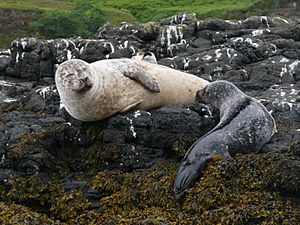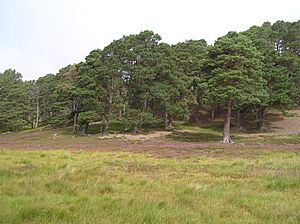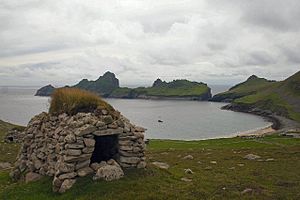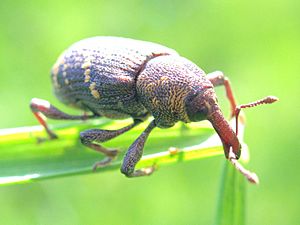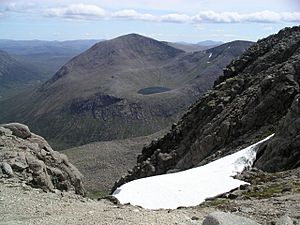Fauna of Scotland facts for kids
The wildlife of Scotland is much like what you'd find in other parts of northwest Europe. However, some of Scotland's larger mammals were hunted until they disappeared a long time ago. Also, people have brought in new types of animals over the years. Scotland has many different kinds of environments, like forests, moors, and coasts. These places are home to 62 types of wild mammals, including wild cats, many grey and harbour seals, and the world's most northern group of bottlenose dolphins.
Many birds that live on the moorland, like the black grouse and red grouse, are found here. Scotland is also a very important place for seabirds to build their nests, such as the northern gannet. The golden eagle is a famous symbol of Scotland. Recently, white-tailed eagles and ospreys have returned to live in the country. The Scottish crossbill is the only vertebrate (animal with a backbone) species that is found only in the UK.
Scotland's seas are full of life, with an estimated 40,000 different kinds of marine animals. The Darwin Mounds are special deep-sea coral reefs found in 1998. On land, nearly 400 different groups of Atlantic salmon live in Scottish rivers. About half of the 42 types of fish in Scotland's fresh waters arrived naturally, while the other half were brought by people.
Only six types of amphibians and four types of land reptiles are naturally found in Scotland. But many kinds of invertebrates (animals without backbones) live there that are rare in other parts of the United Kingdom (UK). Around 14,000 types of insects, including rare bees and butterflies, live in Scotland. Experts who work to protect nature are worried that climate change, especially its effects on mountains and sea life, could harm many of Scotland's animals.
Contents
Scotland's Natural Homes for Animals
Scotland has many different kinds of environments. These include forests with deciduous (trees that lose leaves) and coniferous (cone-bearing) trees, open moorland, mountain areas, river mouths, freshwater lakes, and ocean coasts. About 14% of Scotland is covered by trees. A lot of this is in tree farms, but long ago, there were much larger forests. Even though many trees have been cut down, you can still find important parts of the native Scots pine forests.
Seventeen percent of Scotland is covered by heather moorland and peatland. The areas of Caithness and Sutherland have one of the world's largest and most complete areas of blanket bog. This bog is home to a unique group of animals and plants. About 75% of Scotland's land is used for farming, and cities cover about 3%.
The coastline of Scotland is very long, stretching for about 11,803 kilometers (7,334 miles). There are nearly 800 islands with plants, and about 600 of them are off the west coast. Scotland has more than 90% of the UK's fresh water by volume and 70% by surface area. There are over 30,000 freshwater lochs (lakes) and 6,600 river systems.
By December 2007, 239 places in Scotland, covering over 8,750 square kilometers (3,378 square miles), were named Special Areas of Conservation (SAC) by the European Commission. This was done to protect important habitats. Scotland's seas are among the most productive in the world, with 40,000 or more species. Twenty-four of these SACs are marine (sea) sites, and nine more are coastal areas with both sea and land parts. These marine areas cover about 350 square kilometers (135 square miles). The Darwin Mounds, which cover about 100 square kilometers (39 square miles), are being considered as the first offshore SAC.
Mammals of Scotland
Scotland was completely covered in ice during the Ice Ages. As the weather got warmer and the ice melted, mammals moved into the land. However, when the English Channel formed (as sea levels rose), it stopped more animals from migrating. Because of this, mainland Britain has only two-thirds of the mammal species that reached Scandinavia. The Hebrides islands off Scotland's west coast have only half of the species found in Britain.
Sixty-two types of mammals live wild in and around Scotland, including 13 species found in coastal waters. The number of about a third of the land mammal species is decreasing. This is due to things like pollution, loss of natural areas, changes in farming, too much grazing by animals, and competition from new species that have been brought in.
No mammal species are found only in Scotland. However, the St Kilda field mouse is a special type of wood mouse that is twice the size of its relatives on the mainland. The Orkney vole is another special type of common vole found only in the Orkney islands. It might have been brought there by early settlers about 4,000 years ago. Scotland also has several famous types of farm animals, like Highland cattle, the Shetland pony, Soay sheep, and the Scottish Terrier.
Meat-Eating Mammals
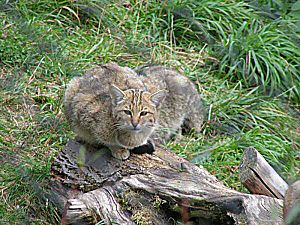
Scotland has many of the same weasel family (Mustelidae) animals as the rest of Britain. However, the European polecat is not found here. Scotland is the main home for the pine marten in the UK. But their pure breed is at risk because some American martens were released in northern England.
Scotland is the only place in the British Isles where you can find European wildcats. There are an estimated 400 to 2,000 of these animals. Scotland also has a special type of red fox that is larger than the more common kind. The wild cat is in danger because laws protecting it are not strong enough, and it is now at serious risk of disappearing. In 2013, it was announced that the island of Càrna would become a safe place and breeding center to protect this species.
Efforts have been made to remove the wild American mink, which were brought to Britain for fur farms in the 1950s. Projects like the Hebridean Mink Project and the Scottish Mink Initiative hope to create a mink-free area from Wester Ross to Tayside.
Only two types of earless seals are found around Scotland's coast: the grey seal and the common seal. These populations are very important globally. In 2002, there were about 120,600 adult grey seals in Scotland, which is about 36% of the world's population. The Scottish common seal population is about 29,700, which is about 90% of the UK's total.
Rodents, Insect Eaters, and Rabbits
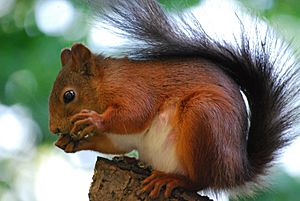
About 75% of the UK's red squirrels live in Scotland. This species is threatened by competition from the grey squirrel, which was brought here. The 'Scottish Strategy for Red Squirrel Conservation' helps protect them for the long term. Research in 2007 showed that the growing number of pine martens helps by hunting grey squirrels more than red squirrels.
Scotland does not have the edible dormouse or hazel dormouse, or the yellow-necked mouse. The Eurasian harvest mouse is only found in the southern part of the country. The St Kilda mouse and Orkney vole are unique to Scotland. Otherwise, the numbers of these animals are similar to the rest of mainland Britain. Black rats are now only found on the island of Inchcolm and the Shiant Islands.
The numbers of insect-eating mammals on the mainland are generally similar to the rest of Britain. Recently, there was a lot of debate about removing European hedgehogs from the Outer Hebrides. Their presence there caused a decline in important breeding populations of wading seabirds like dunlin and ringed plover. Hedgehog removals were stopped in 2007, and the trapped animals are now moved to the mainland. This program has reduced the hedgehog population there.
Among the Lagomorpha (hares and rabbits), only hares and rabbits are found in Scotland. The mountain hare is the only native hare and is common in most of Scotland's uplands. The European hare and European rabbit are also present. Rabbits were brought to Britain by the Romans but did not become common in Scotland until the 1800s.
Hoofed Mammals

The painting Monarch of the Glen by Landseer shows a red deer stag and is a famous image of Victorian Scotland. There are still 400,000 red deer, but their pure form is at risk because they can breed with sika deer that were brought to Scotland. Red deer in Scotland usually live in the hills and are smaller than their European relatives. In lower areas, you'll usually find roe deer instead.
Scotland does not have wild populations of Chinese water deer or many Chinese muntjac. It has isolated groups of wild goats and wild sheep, like the 1,000 Soay sheep on St Kilda. Since 1952, a group of semi-wild reindeer has lived in the Cairngorms National Park. Reindeer had disappeared from Scotland after being hunted in Orkney in the 1100s.
Other Mammals
Only nine of the sixteen or seventeen bat species found elsewhere in Britain are present in Scotland. Common species include common pipistrelles, soprano pipistrelles, the brown long-eared bat, Daubenton's bat, and Natterer's bat. Other bats like the whiskered bat, noctule, Leisler's bat, and Nathusius's pipistrelle are found in fewer places. No bats live on the Shetland Islands, only occasional visitors.
Twenty-one types of cetaceans (whales and dolphins) have been seen in Scottish waters in the last 100 years. These include killer whales, sperm whales, minke whales, and different kinds of dolphins. The Moray Firth has a group of about 100 bottlenose dolphins, which is the most northern group in the world. These dolphins sometimes hunt harbour porpoises. Some people were worried when the UK government allowed oil and gas exploration in the Moray Firth, putting these cetaceans at risk. The government has paused these surveys for more research.
The red-necked wallaby, a marsupial from Australia, has a small group living on an island in Loch Lomond.
Mammal Extinctions and Returns
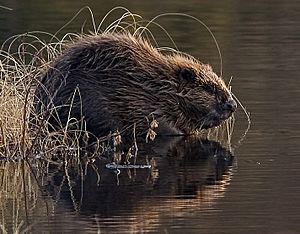
During past warm periods between ice ages, arctic animals that are no longer here lived in Scotland. These included the woolly rhinoceros, mammoth, polar bear, and Arctic fox. Other mammals that used to live in Scotland but died out in the wild during historical times include the Eurasian lynx, which lived in Britain until 1,500 years ago. The Eurasian brown bear disappeared in the 800s or 900s, and the elk lasted until about 1300. The wild boar and wild ox died out in the next two centuries. The last known Eurasian wolf was shot in Invernessshire in 1743. The walrus is now only an occasional visitor. The island of St Kilda also had a unique type of house mouse that died out in 1938.
Scottish Natural Heritage has brought back the European beaver to the wild in Scotland using animals from Norway. Beavers lived in the Scottish Highlands until the 1400s. After some debate, a trial started in May 2009 in Knapdale. In Tayside, beavers that escaped or were released have led to up to 250 animals living in the area. The Scottish Government is watching this situation. Wild boar have also been brought back to several places in Scotland, including Lochaber. There are also ideas to bring back wolves to a wilderness reserve in northern Inverness.
Birds of Scotland
It's hard to make general statements about birds because they can move around so much. Humans have caused a lot of harm to bird species, especially birds of prey. But bird populations naturally change a lot too. For example, northern fulmars were in Skara Brae during the Stone Age, but in medieval times, they only bred on St Kilda. Since then, they have spread throughout the British Isles.
Most of the about 250 bird species regularly seen in Britain also visit Scotland. Perhaps 300 more appear rarely. A total of 247 species have been checked and put on one of three lists: red, amber, or green. These lists show how much concern there is for their future. Forty species are red-listed (most concern), 121 are amber-listed, and 86 are green-listed (least concern).
The Scottish crossbill, which lives in the pine forests of the Scottish Highlands, is Britain's only unique bird. With only 300 breeding pairs, it is one of Europe's most endangered species. Its shape, red/green color, and habit of hanging upside down make it seem like a parrot. St Kilda has a unique type of Eurasian wren, the St Kilda wren. It has adapted to perching on the rocks and cliffs of this treeless island. Because of this, it has developed larger and stronger feet than the wrens on the mainland. It is also a bit bigger, has a longer beak, and a "peculiarly sweet and soft" song. This special wren was recognized in 1884 and protected by a special law in 1904.
Birds of Prey
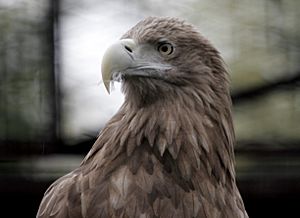
Almost all of Britain's approximately 600 golden eagles are found in Scotland. Most of the breeding peregrine falcons are also here. Birds like the Eurasian hobby, marsh harrier, and Montagu's harrier are found in England and Wales but are generally not in Scotland.
In 1916, a vicar stole the last native white-tailed sea eagle eggs on Isle of Skye. The last adult was shot on Shetland two years later. However, this species was brought back to the island of Rùm in 1975. The birds successfully spread to nearby islands, and 30 pairs were living there by 2006. Despite worries from local farmers, the Royal Society for the Protection of Birds (RSPB) is releasing up to 100 young eagles on the east coast.
The red kite was wiped out in Scotland in 1879. A program to bring them back was started by the RSPB in the 1980s. Even though the species has grown a lot, it's estimated that 38% of the 395 birds that flew between 1999 and 2003 were poisoned. Another 9% were shot or killed by people.
After being gone for nearly 40 years, the osprey successfully returned to Scotland in the early 1950s. There are now 150 breeding pairs.
Other birds of prey found in the UK, such as the common kestrel, hen harrier, northern goshawk, Eurasian sparrowhawk, tawny owl, and barn owl, are common in Scotland. However, the little owl is only found in the south. Buzzards have made a great comeback after being hunted and after a disease in the 1950s reduced their food. Their numbers more than tripled between 1978 and 1998. On the other hand, only one pair of snowy owls bred on Fetlar from 1967 to 1975.
Seabirds of Scotland
Scotland's seas are home to almost half of the European Union's breeding seabirds. This includes about half of the world's northern gannets and a third of the world's Manx shearwaters. Four seabird species have more than 95% of their combined British and Irish population in Scotland. Another fourteen species have more than half of their breeding population in Scottish colonies.
St Kilda, a World Heritage Site, is a very important place for seabirds. It has 60,000 northern gannets, which is 24% of the world's population. It also has 49,000 breeding pairs of Leach's storm petrel, up to 90% of the European population. The island of Mingulay also has many seabirds and is an important breeding ground for razorbills.
Sixty percent of all breeding bonxies nest in Scotland, mostly in Orkney and Shetland. Scotland is also the breeding place for about 90% of the UK's Arctic terns, mostly in Orkney and Shetland. A similar number of the UK's tysties breed on Scottish islands. Scotland also hosts 1,000 pairs of Arctic skua and 21,000 breeding pairs of shag, which is 40% of the world's population of this species.
Over 130,000 birds live at the Fowlsheugh nature reserve in Aberdeenshire during the breeding season. This makes it one of the largest seabird colonies in Britain. The Bass Rock in the Firth of Forth is home to over 40,000 pairs of northern gannets and is the largest single rock gannetry in the world. The bird's scientific name, Morus bassanus, comes from this rock.
Game Birds, Waders, and Waterfowl
Red-listed western capercaillie and ptarmigan breed in Scotland and are not found elsewhere in the British Isles. The capercaillie disappeared from Scotland in 1785 but was successfully brought back from Sweden in 1837. There are many other game birds, including blackcock and the famous red grouse. Common quail, grey partridge, and pheasant are common. A small group of the introduced golden pheasant lives in the southwest.
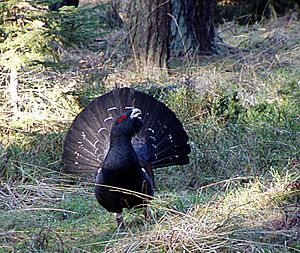
Among the waders, avocet, stone-curlew, and little ringed plover are not found in Scotland. But most of the UK's 100 or so pairs of dotterel spend their summers in Scotland. All of the breeding whimbrel, greenshank, and red-necked phalarope also breed here. In summer, the shallow lochs of the machair lands in the Uists and Benbecula provide a home for many waders and ducks, including shoveler and eider. The rare Slavonian grebe and common scoter breed on a few lochs in the Highland region. Goldeneye have moved into the Cairngorms National Park area since the 1970s, and about 100 pairs breed there. Most of the roughly 25,000 whooper swans in the British Isles spend winter in Scotland and Ireland.
About half of the 80,000 barnacle geese that breed in Greenland come to Islay for the winter. Many thousands more spend winter on other Scottish islands and in Ireland. Tens of thousands of pink-footed geese use the Montrose Basin as a winter resting place in October and November. The red-listed black and red-throated diver's main breeding areas in the British Isles are in the north and west of Scotland.
Other Birds (Not Passerines)
Much effort has been made to protect the shy corncrake. Summer numbers of this red-listed species have grown to over 1200 pairs. The wryneck is almost gone from Scotland, with only one or two birds singing each summer but not breeding. The turtle dove is mostly absent. In the British Isles, the rock dove is only found on the north and west coasts of Scotland and Ireland.
Perching Birds (Passerines)
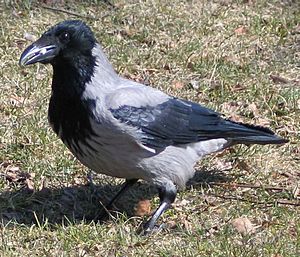
Ravens are usually forest birds in Europe, but in Scotland, they are often found in mountains and along sea coasts. In 2002, the hooded crow was recognized as a separate species from the carrion crow. Scotland and Northern Ireland are home to all of the approximately 190,000 UK territories of the hooded crow. A recent survey suggests that raven numbers are increasing, but hooded crow numbers have dropped by 59%.
About 80 of Britain's 400 pairs of red-billed chough nest in Scotland, mainly on the islands of Islay and Colonsay.
Besides crossbills, crested tits live in small groups of 2,400 breeding pairs in the remaining parts of the Caledonian Forest and some larger tree plantations. Ring ouzels have decreased to around 7,000 pairs, possibly because more people are visiting their mountain homes. There are fewer than 100 breeding pairs of snow bunting, though in winter, more come from Europe. Scotland has 95% of the British breeding population of red-listed twite, about 64,000 pairs. However, a recent RSPB survey found a sudden and big drop in winter numbers from 6,000 in 1998 to only 300 in 2006 in Caithness and Sutherland.
Rare Visitor Birds
Scotland's location on the western edge of Europe means that many birds not usually found in the country visit from time to time. These include accidental visits by birds that have wandered far from their normal homes.
Fair Isle is a famous place for watching migrant birds. Rare birds seen there have included the thick-billed warbler and white-throated sparrow. More than 345 bird species have been recorded on this island, which is only 7.68 square kilometers (2.97 square miles).
Other rare birds seen in 2006 included a white-billed diver at Gairloch and a black-browed albatross in the Western Isles. These records are just a small example of the many different kinds of birds that visit Scotland.
Bird Extinctions
The common crane and great bittern were wiped out by hunters and the draining of marshes in the 1700s. The last great auk seen in Britain was killed on Stac an Armin, a rocky peak in the St Kilda islands, in July 1840.
Fish Life in the Sea
Of the 42 types of fish found in Scottish fresh waters, only half arrived naturally. Native species include allis shad, brown trout, European eel, and river lamprey. Scottish rivers have one of the largest numbers of Atlantic salmon in Europe, with nearly 400 rivers supporting different groups of them. Five fish species are considered 'late arrivals' to Scotland, having come naturally before 1790. These are the northern pike, roach, stone loach, European perch, and minnow.
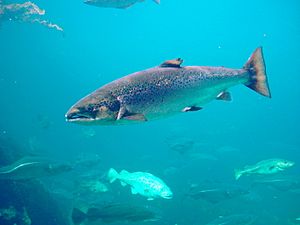
Rarer native species include the unique Salvelinus killinensis and the powan. The powan is found in only two places and is threatened by introduced ruffe and the Arctic charr. The Arctic charr might have been the first fish to return to fresh waters after the last ice age, and about 200 groups of them exist.
The freshwater pearl mussel was once so common that people harvested them for business. Scotland is now the main place in Europe where they are found, with about half the world's total. They live in more than 50 rivers, mainly in the Scottish Highlands. However, illegal harvesting has seriously harmed their survival.
Scotland's seas, which are larger than the seas around the rest of the UK, are among the most productive in the world. They are home to a third of the world's whale and dolphin species. They also have most of the UK's maerl (a type of red seaweed that forms important habitats), Horsemussel beds, and seagrass beds. Unique species like the tall sea pen also live here. It is thought that the total number of Scottish marine species is over 40,000. This includes 250 types of fish, with saithe being the most common in coastal waters. Deeper waters have creatures like the dogfish, porbeagle, blue shark, European eel, sea bass, Atlantic halibut, and various rays. There are four types of sea turtle: the leatherback, loggerhead, Kemp's ridley, and green turtle. Scottish waters contain around 2,500 crustacean species and 700 molluscs. In 2012, a bed of 100 million flame shells was found in Loch Alsh.
The Darwin Mounds are an important area of cold water coral reefs discovered in 1998. They are about 1,000 meters (3,281 feet) deep in the Atlantic Ocean, about 185 kilometers (115 miles) northwest of Cape Wrath. The area covers about 100 square kilometers (39 square miles) and has hundreds of mounds. The tops of these mounds have living Lophelia corals and other unique creatures. Damage from trawler fishing was seen over about half of the eastern Darwin Mounds in 2000. The UK government is working to protect the area. In 2003, the European Commission banned harmful fishing in the area.
More action on a much larger scale might be needed. A recent report said that "Scotland's marine life could be almost wiped out within 50 years" if strong action isn't taken to manage how people use the seas. Environmental groups worried that commercial fish stocks, like Atlantic cod, are being overfished. They also said that fish farming, especially for salmon, is harming the water environment. A decrease in coastal marsh habitats is affecting sea birds. Litter in busy river mouths like the Firth of Clyde is affecting all marine life. And the growth in offshore tourism was bad for populations of, for example, basking shark. A call was made for a 'Scottish Marine Bill' to manage human activity at sea and create more protected areas. The Marine (Scotland) Act 2010 was later passed by the Scottish Parliament.
Calyptraea chinensis (L.), a type of sea snail, has moved into Scotland's shores. By 1998, it had reached almost as far north as Oban.
River Fish Extinctions
Pollution and being eaten by other animals led to the disappearance of both types of vendace from their very small home in southwestern Scottish freshwaters in 1980. In the 1990s, a successful effort to bring Coregonus vandesius back to the Lochmaben area began.
Salvelinus inframundus, a rare type of char fish that might be vulnerable to extinction, has been found in Loch Mealt, Isle of Skye.
Amphibians and Land Reptiles
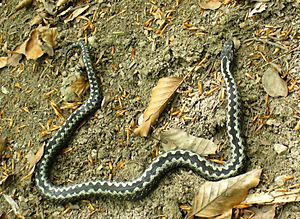
Only six types of amphibians and four types of land reptiles are naturally found in Scotland. The amphibians include three types of newt: the great crested newt, with fewer than 1,000 individuals left; the smooth newt; and the palmate newt. The other amphibians are the common toad, the natterjack toad (found in only four places in the southwest), and the common frog. One non-native amphibian, the Alpine newt, has recently escaped and is only found in the Edinburgh area.
The reptiles include the adder and the grass snake. There is also the slow-worm, which is a lizard without legs, and the common lizard. Smooth snakes, found elsewhere in the UK, are not in Scotland, and grass snakes are rarely seen.
Land Invertebrates
Seventy-seven types of land snails and an estimated 14,000 types of insects live in Scotland. None of them are truly unique to Scotland. These include Pardosa lugubris, a type of wolf spider first found in the UK in 2000 at Abernethy Forest nature reserve, and the Scottish wood ant. These ants build mounds from pine cones and needles and can live in them for decades. A single colony can collect 100,000 insects a day to feed its half-million ants.
Besides the Scottish wood ant, several Scottish invertebrate species are rare in the UK and important enough to have a special "Action Plan" to protect them. These include five types of ant and bee, six moths and butterfly species, five flies, and one beetle (the reed beetle) and one snail. Northern colletes is a rare type of bee, and its most important British home is in the Outer Hebrides, where there are more than ten colonies. Scotland is also the main home for the Blaeberry bumblebee. The Bumblebee Conservation Trust recently created the world's first safe place for this type of insect near Loch Leven. The bumblebee Bombus jonellus var. hebridensis is unique to the Hebrides. In 2010, a group of the beetle Meloe brevicollis was found on the island of Coll. This species is otherwise gone from Scotland and cannot fly, which makes its presence on the island a mystery. The northern February red stonefly is now considered unique to Scotland.
Even though many types of butterfly are decreasing in the UK, recent research suggests that some, like the pearl-bordered fritillary and chequered skipper, are moving north into Scotland. This is happening because of climate change. In June 2008, an adult Ethmia pyrausta moth was found in Easter Ross. This was only the fifth time it had been seen in the UK since 1853.
The most well-known invertebrate might be a type of midge (Culicoides impunctatus). This tiny flying gnat is a big problem for summer visitors and locals. Its bites can cause up to 20% of summer working days to be lost in the forestry industry. Other important insects include the pine weevil, black pine beetle, clytra beetle, and the timberman. The ancient site of Skara Brae provided the earliest known record of the human flea in Europe.
The islands of Colonsay and Oronsay are home to about 50 groups of the only native species of honeybee in Britain, Apis mellifera mellifera. The Scottish Government passed a law in 2013 to protect this species from cross-breeding and disease, as it has greatly decreased on the mainland.
Mysterious Animals (Cryptozoology)

There are rumors of various unusual cats existing, including the 'Beast of Buchan'. The 'Kellas Cat' of Moray is a jet-black, long-legged animal. It is probably a mix of a modern wild cat and a domestic cat, or a very dark wild cat. Long ago, it might have inspired the legend of the Cat Sidhe or "Fairy Cat." The famous Loch Ness Monster, possibly a type of "water horse," has a long history. The first recorded sighting supposedly happened in 565 AD. More recently, the Stronsay Beast was an unknown creature that washed ashore in the Orkney islands in the 1800s.
Protecting Scotland's Wildlife
Challenges for Wildlife
Protecting the natural environment is very important in the United Kingdom. The groups working on this might not have enough resources, but their efforts are very different from how people used to think about nature. In Victorian times, few animals disappeared in Scotland, but many were killed on hunting estates. Richard Perry wrote that on a single estate in the Cairngorms between 1837 and 1840, gamekeepers killed many animals just to protect the red grouse population. For example, they killed:
- 246 Martens
- 198 Wild Cats
- 106 Polecats
- 67 Badgers
- 58 Otters
- 475 Ravens
- 462 Kestrels
- 371 Rough-legged Buzzards
- 285 Common Buzzards
- 275 Kites
- 98 Peregrine Falcons
- 92 Hen Harriers
- 78 Merlins
- 71 Short-eared Owls
- 63 Goshawks
- 35 Long-eared Owls
- 27 Sea Eagles
- 18 Ospreys
- 15 Golden Eagles
- 11 Hobbys
- 6 Gyrfalcons
- 5 Marsh Harriers
- 3 Honey Buzzards
And for reasons not related to grouse hunting, they also killed:
- 11 Foxes
- 301 Stoats and Weasels
- 78 House Cats
- 1,431 Hooded or Carrion Crow
- 3 Barn Owls
- 8 Magpies
- 7 "Orange-legged Falcons"
Perry wrote in 1947 that his "first reaction to this dreadful black-list was that of amazed incredulity. I still find the details incredible. However, they were supplied by the lessee himself." In many cases, these numbers are larger than the current total numbers of these animals in the entire country.
It is still unknown if the harm caused by the Victorians will be the worst period for Scotland's animals. Besides other problems the marine environment faces, climate change is a challenge for all of Scotland's habitats. Among birds, ptarmigan, dotterel, and snow bunting might be especially affected. They rely on high-altitude places, and their populations will likely decrease if warmer weather brings other animals into their limited areas. Mammals and other animals with backbones might do better, but small invertebrate populations are at risk.
Marine life is already being affected. Tiny plankton species that like cold water are decreasing. This means they cannot support the important food chains that many seabirds depend on. More evidence of problems for marine species has come from the University of St Andrews Sea Mammal Research Unit. An analysis suggests that common seal populations in Orkney and Shetland fell by 40% from 2001 to 2006. This led the Scottish Government to announce that a new protective order would likely be put in place.
The difficulties in protecting Scottish wildlife are shown in an RSPB report. It noted that pine martens have been found to eat many capercaillie nests. Both species are protected, which creates a difficult problem for conservation groups to solve. In 2012, the Scottish Government published a "Code of Practice on Non-Native Species." This helps people understand their responsibilities and explains which public body is in charge of different habitats.
Groups That Protect Nature
Various public organizations play an important role in looking after Scotland's animals. Scottish Natural Heritage is the official body responsible for managing Scotland's natural heritage. One of its jobs is to create National Nature Reserves (NNRs). Until 2004, there were 73, but a review in that year led to many sites losing their NNR status. As of 2006, there are 55. The Forestry Commission in Scotland is the forestry department of the Scottish Government and owns a lot of land in the country. The Joint Nature Conservation Committee advises the Government on UK and international nature conservation.
Scotland has two national parks. Cairngorms National Park includes the largest area of arctic mountain landscape in the UK. Places important for natural heritage make up 39% of the land area, and two-thirds of these are important across Europe. Loch Lomond and The Trossachs National Park includes Britain's largest body of fresh water, the mountains of Breadalbane, and the sea lochs of Argyll.
Charities and volunteer groups also play important roles. The National Trust for Scotland is a charity that protects and promotes Scotland's natural and cultural heritage. With over 270,000 members, it is the largest conservation charity in Scotland. The Scottish Wildlife Trust is a leading volunteer conservation group working to protect Scotland's natural environment. The Royal Zoological Society of Scotland is a charity that runs Edinburgh Zoo and the Highland Wildlife Park. The Society is also involved in various conservation programs. The Royal Society for the Protection of Birds works to protect birds and other wildlife by protecting and creating habitats. The John Muir Trust is a charity that guards wild land and wildlife. It owns and manages estates in places like Knoydart and Assynt, and on the Isle of Skye. Trees for Life is a charity that aims to bring back a "wild forest" in the Northwest Highlands and Grampian Mountains.
Images for kids
-
Atlantic salmon (Salmo salar)
See also
 In Spanish: Fauna de Escocia para niños
In Spanish: Fauna de Escocia para niños


